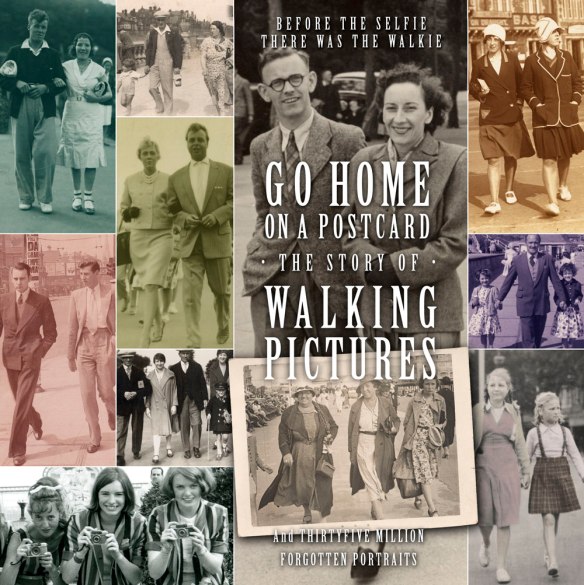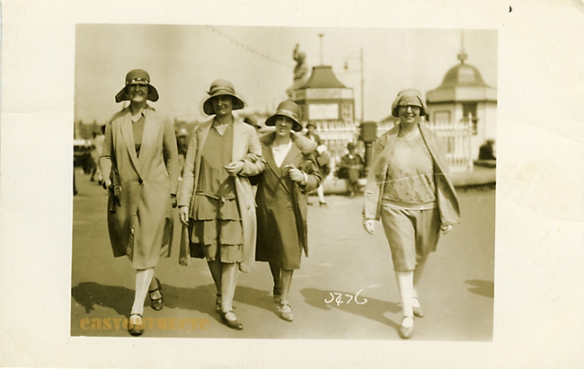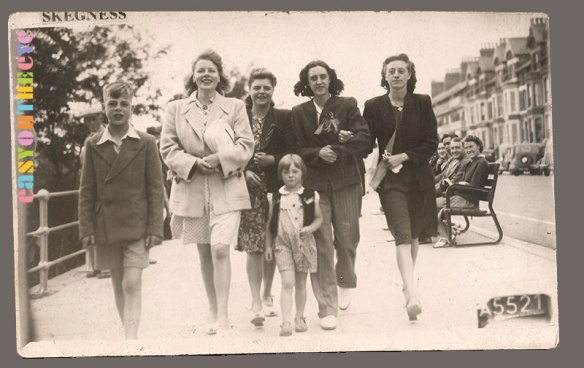NEWS • It is a good idea to join the newsletter service which will keep you updated on progress and details of any pre-publication offers. This service is provided by the book’s publishers. Your details will be kept confidential and you can unsubscribe at any time. Click the button below for details:
PREVIEWS • There are several new preview page spreads on the site to look at and these show how the final layout will look. The book should finally appear in 2024 after delays caused by the lockdowns, Brexit (we print in Europe) and illness! The cover design has also been updated, see below. You can view a turn page preview on screen by visiting our Flipbook gallery: https://online.fliphtml5.com/msya/ewry/
VIDEO • There is a sixty second video for the book on our YouTube channel with photos and information. A short new video of walking pictures taken in Mablethorpe has also been released.

Go Home On A Postcard – cover
BOOK DETAILS • From around the start of the twentieth century, right up until the 1970s, street photographers were busy in holiday resorts all around Britain. It was a speculative trade; of the many hundreds of thousands of images they must have taken, it’s impossible to say what percentage were ever collected, but those that survive form a unique record of society. What makes these photographs so special is that the subjects didn’t expect to have their photograph taken, so they dressed as society at the time dictated. Thus the images capture a moment in time, reflecting the fashions, social status and habits of the era.
This book is the first to collect a selection of these walking picture images, taken by companies with such names as Walkie Snaps (from Blackpool), Skeg-cards (from Skegness you’ll not be surprised to learn), The Krazy Komic Studios (a name which seems to come straight out of the pages of the novel Brighton Rock, fittingly they had their booth in the arches on that town’s Esplanade), Sunbeam and Sunny Snaps (who both worked the resorts on the Kent coast).
Walking Pictures reached a peak during the 1930s but the trade resumed after the second World War and was still popular through the Fifties and into the Sixties. The prints were very popular, and appealed to a wide spectrum of people and classes, despite the advent of cheap cameras which a lot of families would own at the time.

Four ladies on holiday Great Yarmouth 1928, Walking Picture postcard
Walking Picture cameramen often had their own ‘beat’, busy spots where they could guarantee a steady flow of people passing by. It’s clear that a lot of the people simply didn’t realise they’d been photographed, while others are looking right at the camera and smiling. Sometimes the same family would be photographed over different days on the same holiday, mother and father, grandparents, in-laws and children. Other families would be captured in walking pictures for several generations
Once your photograph had been taken, you were given a slip showing you where to view the print. The reel of film would be developed and printed (usually on postcards) in just a couple of hours and then posted up in a shop window or cabinet. If you liked the result you just popped in and bought it.
This photographic journey around the vanished townscapes of Britain includes a detailed history of the Walking Picture from the early 1900s, several hundred annotated examples, as well as pages devoted to some of the major firms involved in the trade, examples of the cameras used and more. The images have come from several collectors, as well as museums and archives. There is a growing interest in this area of ‘found’ photography today, and this is an important contribution to the history of the genre.

The Frogatt family on Holiday, Skegness, 1948.
Sewerby Hall near Bridlington had a display of local Walking Pictures from the book during the summer season in 2011 (learn more here). There is a web site devoted to Walking Pictures where you can learn more (and maybe contribute scans from your own albums). A couple more examples can be found here on the site, along with more information and details of how to send in any examples they may have.
AUTHOR • The book has been written and researched by Simon Robinson: “This subject has fascinated me since art college days, and I had originally intended it to be a book just of photographs. However as I began discovering more about this trade, it became clear that it was worth documenting properly, so this book is part visual exploration, and part history!” Simon works as a designer for Easy On The Eye, and has given talks on Walking Pictures and authored some of their other books, including one on Bizarre Vinyl Art in 2023.


Hello Simon,
Just to say that I enjoyed reading your article in Best of British about prom pictures. I write articles for the Scottish equivalent, called Scottish Memories. Small world. Anyway, you’ll be glad to know that the photographers were still working up here in Scotchland up until the seventies. I have a personal archive of family memories and photos over at http://www.stuarthamilton.co.uk/family/ and if you go to the page which has my Great Aunt Euphemia and Great Uncle George (who looked after me when I was a wean), there’s one of them taken when they, me and my Mum and Dad were on holiday in Oban. I was six or
seven, so it would have been about 1972 / 1973. The direct link is http://s1.zetaboards.com/Mr_H_Family_Album/topic/1327829/1/ and you’ll find it in the third lot of pictures from the top.
Further down there’s an Edinburgh one from the 1930’s captioned “This is Mamie with A N Other and my Auntie Molly (centre)”, which shows they worked the tourist beat, even away fae the seaside. It would have been a big day out for Molly, who was in town to visit Mamie (the Great Aunt Euphemia mentioned above), as she lived in a mining village in West Lothian with my Dad, her big brother.
Best of luck with the book.
Regards,
Stuart Hamilton
Hi
I work on a programme which is interested in doing a feature on this book. Would someone be able to contact me please? Caroline
As student at Manchester University, in 1958, I took a summer vacation job with Walkie Snaps on the Central Pier at Blackpool. I was equipped with a large, heavy, wooden camera, mounted on a tripod, with a small handle on the side which was turned for each exposure. This was set up on the pier itself close to and facing the entrance. Potential customers were snapped as they approached and given a ticket which they presented to the kiosk at the entrance if they wished to buy the resulting picture.
The best time for taking pictures was on a Sunday morning as the new set of holidaymakers, who had arrived on the previous day, were in a good mood and still had money to spend. Friday afternoon was the worst as they were going home the next day and were stoney broke! Some people would refuse a ticket, others would say that they had been snapped the day before and regular walkers might raise a hand to indicate that they weren’t interested in having their picture taken. Occasionally clients actually requested one snap or more to include all the family.
The photographer had to make a quick decision as to the composition of the picture. Snaps of a single person were less likely to be bought than those of a couple; pictures of three or more people could easily include total strangers; even in 1958 a couple may not have wanted to be seen together!
Each week brought new customers from the different towns of Lancashire as the factories closed during the “wakes weeks”. I can’t remember if Blackburn folk were more likely to buy a photo than Bolton folk, or whether Burnley people were more cheerful than those from Bury but I do recall that the Scottish visitors were more careful with their hard-earned wages!
The Pier, of course, was not just for walking or sitting on. Each of the town’s piers and theatres had its own summer show and the Central Pier, that year, starred Ken Dodd and Joseph Locke. “On your right for the show tonight” was the cry over the loudspeakers directing customers to the ticket office. I did see both of them from time to time as they arrived for rehearsals and they sportingly posed for pictures.
After the season finished I returned to my studies with a little extra money, a deep suntan and a lot of memories.
Alan Purvis
Durham City
I assume you are aware of the The South East Archive of Seaside Photography (SEAS Photography) project (http://www.seasphotography.org.uk/about-seas-photography). They are compiling a collection of walkies as well as digitising photographs from Sunbeam (the ones formerly housed in Margate Museum.
I have a sunny snap postcard that says SUNNY SNAPS 1936 SOUTH COAST Then the handwritten number 2599. On the back my mum has written The girls on the prom on Tuesday Aug 14th. They lived in Derby. I can’t recognise the prom from any photos I can see on line. Any ideas
Pingback: Walking pictures | Go Home On A Postcard
Do you have any photos of your photographers in the summer of 1964 we used to wear striped jackets and used olympus cameras, I worked for Wrates in Skegness We had our photos taken at the begining of every reel of film
Can anyone help me on this: What was the PRICE of a walkie snapped in Blackpool during the 1950s? Was there a special deal if you bought 2 of them? Or maybe 3?
I cannot say exactly at Blackpool, but most firms charged similar prices. In Skegness, one postcard was priced at 1s 3d at this time. Blackpool usually sold two half size prints instead of a postcard.
Came across this today. Whether or not it will be of interest, I worked at Meech’s in Weymouth in the late 50’s. They had a portrait studio, and darkroom. Most of the revenue was from School photographs during the winter, and “walking photos” taken of day trippers and holidaymakers during the summer months. Ronald Meech and two photographers took the snaps using Leica 250’s. One was a gorgeous young American woman, and the other was called Bernard, I believe, who was a sharp dresser and knew the business.The processing was done by hand by three “apprentices” ( a misnomer – it was cheap labour), and I was one – all day and often until 10. 00 p.m.throughout the summer so that photos were on view the following morning at 9a.m., seven days a week. Drying the negatives was done by immersing in methylated spirits and either setting fire and waving them about, or putting in the drying cabinet. It was batch processing using your bare hands in the developer and fixer. It played hell with your skin after weeks of doing it. Meech had a kiosk at West Bay during the summer months, and had a darkroom in Bridport for some time. Sometimes there was trouble when a rival bunch of beach photographers came down from Brighton to cash in on evening work. The boss owned a flash Ford Zodiac with sun visor, and bought two Renault 500’s for the photographers doing school visits. I remember that some people described him as “a bit of a wide boy” . His wife was a lovely person who ran the business side.
Pingback: Book updates | Go Home On A Postcard • Vintage seaside photography
Pingback: Font conflict | easy on the eye